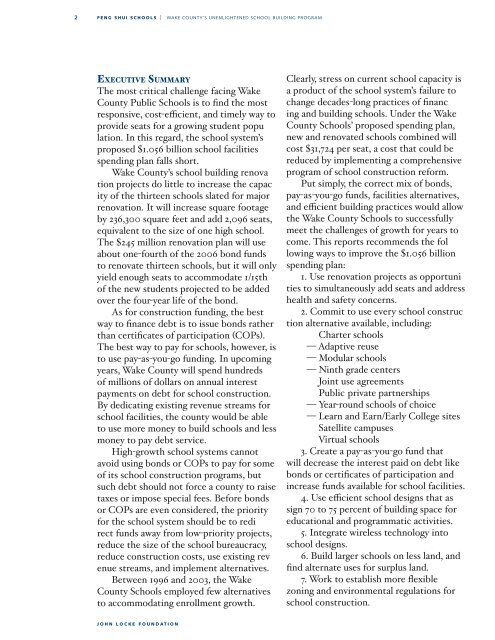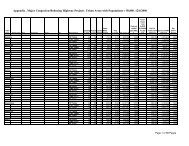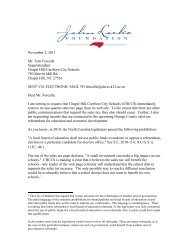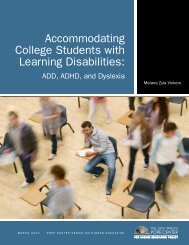Feng Shui Schools - John Locke Foundation
Feng Shui Schools - John Locke Foundation
Feng Shui Schools - John Locke Foundation
You also want an ePaper? Increase the reach of your titles
YUMPU automatically turns print PDFs into web optimized ePapers that Google loves.
f e n g s h u i s c h o o l s |<br />
wake County’s unenlightened school building program<br />
Executive Summary<br />
The most critical challenge facing Wake<br />
County Public <strong>Schools</strong> is to find the most<br />
responsive, cost-efficient, and timely way to<br />
provide seats for a growing student population.<br />
In this regard, the school system’s<br />
proposed $1.056 billion school facilities<br />
spending plan falls short.<br />
Wake County’s school building renovation<br />
projects do little to increase the capacity<br />
of the thirteen schools slated for major<br />
renovation. It will increase square footage<br />
by 236,300 square feet and add 2,096 seats,<br />
equivalent to the size of one high school.<br />
The $245 million renovation plan will use<br />
about one-fourth of the 2006 bond funds<br />
to renovate thirteen schools, but it will only<br />
yield enough seats to accommodate 1/15th<br />
of the new students projected to be added<br />
over the four-year life of the bond.<br />
As for construction funding, the best<br />
way to finance debt is to issue bonds rather<br />
than certificates of participation (COPs).<br />
The best way to pay for schools, however, is<br />
to use pay-as-you-go funding. In upcoming<br />
years, Wake County will spend hundreds<br />
of millions of dollars on annual interest<br />
payments on debt for school construction.<br />
By dedicating existing revenue streams for<br />
school facilities, the county would be able<br />
to use more money to build schools and less<br />
money to pay debt service.<br />
High-growth school systems cannot<br />
avoid using bonds or COPs to pay for some<br />
of its school construction programs, but<br />
such debt should not force a county to raise<br />
taxes or impose special fees. Before bonds<br />
or COPs are even considered, the priority<br />
for the school system should be to redirect<br />
funds away from low-priority projects,<br />
reduce the size of the school bureaucracy,<br />
reduce construction costs, use existing revenue<br />
streams, and implement alternatives.<br />
Between 1996 and 2003, the Wake<br />
County <strong>Schools</strong> employed few alternatives<br />
to accommodating enrollment growth.<br />
Clearly, stress on current school capacity is<br />
a product of the school system’s failure to<br />
change decades-long practices of financing<br />
and building schools. Under the Wake<br />
County <strong>Schools</strong>’ proposed spending plan,<br />
new and renovated schools combined will<br />
cost $31,724 per seat, a cost that could be<br />
reduced by implementing a comprehensive<br />
program of school construction reform.<br />
Put simply, the correct mix of bonds,<br />
pay-as-you-go funds, facilities alternatives,<br />
and efficient building practices would allow<br />
the Wake County <strong>Schools</strong> to successfully<br />
meet the challenges of growth for years to<br />
come. This reports recommends the following<br />
ways to improve the $1.056 billion<br />
spending plan:<br />
1. Use renovation projects as opportunities<br />
to simultaneously add seats and address<br />
health and safety concerns.<br />
2. Commit to use every school construction<br />
alternative available, including:<br />
— Charter schools<br />
— Adaptive reuse<br />
— Modular schools<br />
— Ninth grade centers<br />
— Joint use agreements<br />
— Public-private partnerships<br />
— Year-round schools of choice<br />
— Learn and Earn/Early College sites<br />
— Satellite campuses<br />
— Virtual schools<br />
3. Create a pay-as-you-go fund that<br />
will decrease the interest paid on debt like<br />
bonds or certificates of participation and<br />
increase funds available for school facilities.<br />
4. Use efficient school designs that assign<br />
70 to 75 percent of building space for<br />
educational and programmatic activities.<br />
5. Integrate wireless technology into<br />
school designs.<br />
6. Build larger schools on less land, and<br />
find alternate uses for surplus land.<br />
7. Work to establish more flexible<br />
zoning and environmental regulations for<br />
school construction.<br />
J o h n l o c k e f o u n d a t i o n










